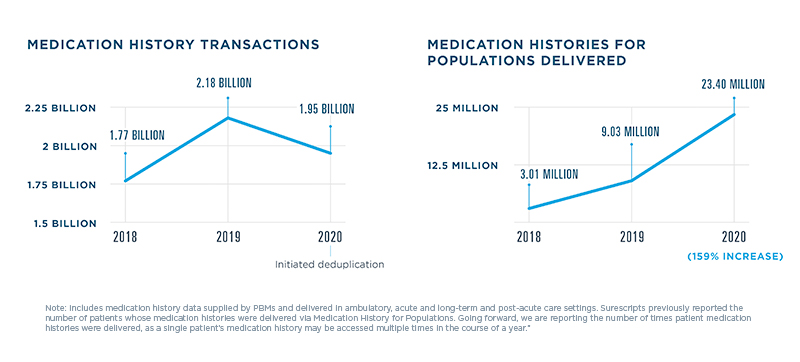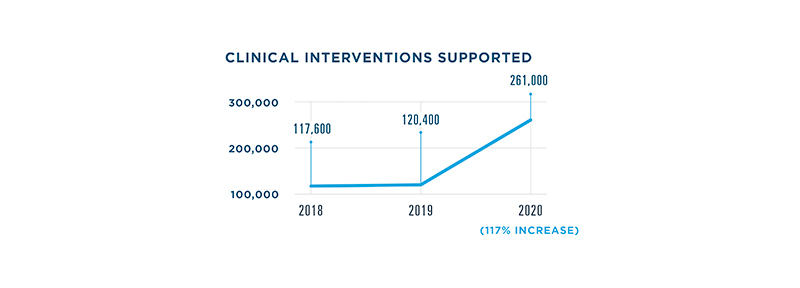We recently released Surescripts 2020 National Progress Report, an annual milestone that gives us perspective and a chance to reflect on the year that was. It also invites us to think strategically about the future—which admittedly feels harder than ever to predict—and where we might double down on technologies that serve the greatest good of a nation in recovery mode.
COVID-19 undoubtedly continues to transform U.S. care delivery, but the impact it’s had on patient behavior has our full attention.
As the crisis worsened, patients weighed the risks of leaving the house to spend time in person with their care providers. What was once merely a waiting room became a potential danger zone, particularly for seniors and patients with chronic health conditions or other risk factors.
As a result, many patients postponed or skipped the care they needed. And the data tells us that they may have ended up sacrificing their long-term health for their short-term safety. Our Chief Executive Officer Tom Skelton spoke to this in his health IT predictions for 2021.
“One of the calamities of COVID-19 is that patients have put off medical care. Some skipped routine screenings that are leading to missed and delayed cancer diagnoses, while others with chronic or complex conditions skipped essential treatment. Information about high-risk populations will be critical for health plans, providers and public health to address the latent risk of postponed care.”
Thirty-six percent of nonelderly adults and 29% of children delayed or skipped care because of concerns about exposure to COVID-19. And during the pandemic’s first peak back in March 2020, ambulatory care visits declined nearly 60%.
As an industry, we must position ourselves to meet the demands of the “COVID fallout” in the coming years, which some experts say will bring with it a “cancer pandemic.”
Chronically and seriously ill patients whose diagnosis and treatment were delayed could be at a higher risk for worse health outcomes. And realizing the full potential of care management programs will require clinicians and organizations across the country to tune out the noise and bring timely patient insights into focus.
As patients who have gone off the care grid return to their regular care settings, health systems, hospitals and clinicians will need insight on their medication histories, care gaps and adherence information—especially for the at-risk or newly at-risk populations they serve.
Information about high-risk populations will be critical for health plans, providers and public health organizations to address the consequences of postponed care. Likewise, the notion of seamless and reliable information-sharing must become the new normal rather than the exception.
How the Surescripts Network Alliance Supported Care Management in 2020
Medication History accessed via clinicians’ electronic health record (EHR) or analytics platform help identify and close gaps in care, uncover medication non-adherence and manage at-risk populations.

Insights for Medication Adherence helped more clinicians identify adherence issues and gaps in care with patient-specific medication summaries and real-time messages from pharmacy benefit managers (PBMs) and health plans. Clinicians used this technology to support more than 260,000 clinical interventions This includes uses cases like the clinician receiving an in-workflow alert that a patient isn’t taking their medications as prescribed, or when a patient is missing medications prescribed for a new disease state like congestive heart failure or depression.

Medication History for Populations helped clinicians at Aledade, a physician-led network of accountable care organizations, address nonadherence, resulting in:
- Reduced false positives for medication non-adherence by 26% by eliminating 585 unnecessary patient interventions out of 2,235 opportunities identified from payer claims data
- Pay-for-performance bonuses under the CMS Five-Star Quality Rating System for Medicare Advantage contracts: diabetes (4 stars), cholesterol (4 stars) and hypertension (5 stars)
While nobody could have predicted the magnitude of the challenges we faced in 2020, Skelton understood that “delays in essential care would be a systemic issue.” As he explained, “Patient activity in 2021, like provider visits, lab tests, procedures and prescriptions, will be closely watched. Will the system return to the status quo or reach a new normal that is more heavily reliant on digital interactions and transactions like healthcare reminders, helping patients manage their health? Trend data on essential activities like going to the doctor, getting a lab test, getting a medical procedure or getting a prescription, will tell us a fascinating story.”
It’s clear that the information that was essential during the pandemic will be increasingly crucial as we emerge from it. And I believe that healthcare’s ability to navigate disruption with collaboration and innovation and our industry’s astounding collective rise to the challenge of COVID-19 have made the Surescripts Network Alliance better prepared than ever to deliver on the promise of nationwide interoperability.
Together, we will prove once again the value of enabling doctors, pharmacists and other clinicians to make better-informed decisions across care settings—as well as to deliver and exchange patient information, track medication adherence, and intervene proactively. The technologies that we use will be the bridge across which we safely usher millions of Americans to the other side of this crisis—and to a brighter future where better data, better care and positive outcomes are more accessible and affordable.
For more about how the digital transformation of healthcare accelerated in 2020, be sure to read the press release and visit Surescripts 2020 National Progress Report.


 Dean Riggott Photography
Surescripts
Dean Riggott Photography
Surescripts



